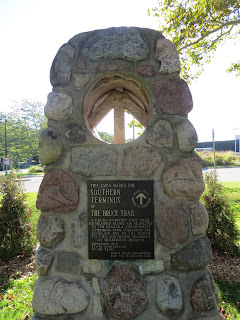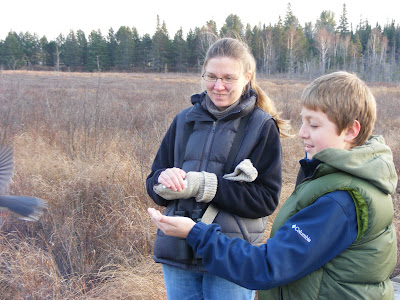Rolling Back the Clock : Life Challenges and the Need for Nature
Rolling Back the Clock
Essential Lessons are Learned in Nature
After 30
hikes and blogs about our time on the Bruce Trail, which took us along the
Niagara Parkway Trail and from Queenston Heights to Owen Sound, it is time to
share the final push from Owen Sound to Tobermory! Ironically, however, the last segment of the
BTC that we will share was in fact the first section that we hiked. In fact, it was also our first major long-distance trek – undertaken so many years ago in 2014.
In order
to keep things as straightforward as possible, these blogs (as we have
mentioned before) have been presented in geographic order from south to north,
rather than in the chronologic order we hiked the segments. Regardless, owing to other obligations, work,
and the usual distractions which life brings about, it took us from 2014 until
2022 to complete every section of the Bruce Trail from the southern terminus in
Queenston Heights to the northern cairn in Tobermory.
As such,
our final entries for our Bruce Trail
blog are from many years ago, and from a time when we knew far less (actually
nothing) about hiking and backpacking.
We were also very much younger, and we were struggling with a number of
family issues. During this first trek,
our attitudes were different, our goals were different, and of course, our abilities
and sense of hiking were different. On
that first thru-hike, we made every possible mistake we could – from our choice
of gear, to what we carried, to setting unreasonable goals each day. Yet despite the setbacks and challenges,
those seven to ten days on the Bruce Trail in 2014 put our feet and lives on a
different pathway forward.
Disconnected from the World
Admittedly,
we did not simply decide one afternoon to begin hiking the Bruce Trail. In fact, it took a crisis to push us out the
door. Unfortunately for him, too
many teachers allowed this situation to go on too long, and the consequences of
this lifestyle were catching up. By
Grade 11, concerned educators finally began to stop accepting the excuses and
to worry about how he would navigate the world.
Children need Nature
The situation our younger relative was experiencing, and which so many today strive to navigate, has always made me wonder. How did we get to the point where we now strive to limit children’s experiences of the world? When did we stop letting them explore and experiment with nature, allowing them to figure out themselves, find their own strengths, and learn to accept their own limitations?When I was younger, the answer from my
parents for almost every situation was to send me outside to play. As children
and teenagers, we have an abundance of energy that needs to be burnt off, and
nature is a great place for that.
Outdoors, I learned what my body could and could not do, I learned that
you scraped your knee when you fell and that you could get hurt when you fall
out of a tree. In short, I learned by
doing, not by Googling and watching a YouTube video on it. Accomplishments in life were our achievements, not digital rewards for moving across a screen and hitting buttons.
Disconnect to Reconnect
It would take two months of concerted effort for us to finally convince his family that time outdoors was a way to get things back on track, and to foster a connection with the world. Even then, the belief that “time in nature is unnatural” and fears that “walking is stressful and wastes back and knee energy” pervaded. While neither of these reactions was unexpected, what was not anticipated was the degree of fanaticism with which they were presented. In particular, the concept of being offline and without a cell phone, and missing TV shows and game updates seemed akin to subjecting this young man to ritual abuse.Interestingly, however, none of these “concerns” were levelled at the
practical issues we were still to face on the trail. Questions such as where would we get clean
water each day? Where would we refill
our food supplies? What if any of us were
injured on the trail? How were we to get back to our car from Tobermory? Instead, the “concerns about hiking” all
revolved around unplugging from the online world. Ultimately it was their own desire to spend uninterrupted time watching movies and texting that allowed him to come walk with us.
Unsurprisingly,
the inspiration in 2014 for setting out onto the Bruce Trail – trekking from
Owen Sound to Tobermory – was to encourage our younger relative to disconnect
from his electronic devices and reconnect to nature. Hopefully, in the process of doing so, he
would gain a sense of himself, a sense of what he could achieve, and find an
interest beyond the online world he presently lived in.
With understandings reached and plans made, we only had one challenge. The fact that, at that time, we had never hiked this sort of distance before.
Outdoors Experiences before the Bruce Trail
To be clear, the fact that we had not gone on a thru-hike together is not to suggest that we had no experience in the outdoors. Sean grew up attending the Scouts and going to summer camp in Algonquin Provincial Park, while I participated in annual week-long backcountry hiking, canoeing, and camping trips at school, and later spent several years working as part of scientific research teams in forests across Ontario. In addition, we had spent many weekends and months front country camping, as well as going on day hikes with our relatives in parks across the province.A Brief Aside
As a side note – keen observers will notice that the extensive photography that accompanies our blogs for the European Caminos, East Coast Trail, and Trans Canada Trail adventures does not exist for this stretch. During our first hike on the Bruce Trail from Owen Sound to Tobermory, Sean carried a camera with only five rolls of actual film – so the pictures taken were far fewer.** To read about our birding hike along the
East Coast Trail click this link.
** To read about our birding hike along the Trans Canada Trail click this link.
See you on the Trail!












.JPG)
Comments
Post a Comment